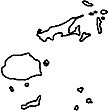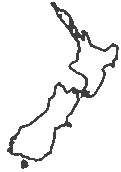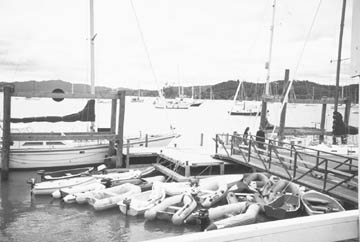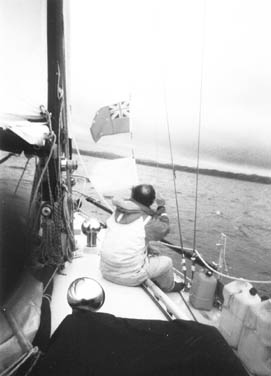 Fiji to New Zealand
Fiji to New Zealand
By Michaelle Wetteland
The Autumn chill was just beginning to invade the evening air when we
received the telephone call from Tonga. A Minneapolis couple we knew had left a year and a
half earlier, from Barker's Island Marina, to sail their boat and immigrate to New
Zealand. They were calling to see if we wanted to sail the leg from Fiji to New Zealand.
The timing could not have been better for us, having just completed the sailing season on
Lake Superior.
So, on October 20, 1998, we flew out of the Minneapolis/St. Paul
airport for Fiji. Some fifteen hours later we landed in Nadi on the Fijian island of Viti
Levu. As the flight attendants prepared the passengers to disembark, an announcement
informed us that we had a message waiting in the cockpit. It was from our captain, telling
us he was at the Royal Suva Yacht Club. We found a local bus which charged us a mere $8.00
to take us the 150 miles across Viti Levu from Nadi to Suva. Five hours after boarding the
bus, we found our boat and captain. However, instead of making the anticipated pier head
jump from bus to boat to ocean, we spent two weeks in Suva waiting for typhoons to
dissipate.
 Fiji was hot and sultry with daily rain that
either came as a torrential downpour or gentle mist. Either way, it was always a welcome
relief from the heat. To help pass the time, we visited the Fijian Magistrate and
Appellate Courts and attended a medical conference at the Fijian Colonial Hospital. We
found it fascinating how different and yet how similar they were to their contemporaries
in the United States. Although two cultures coexist in Fiji, the Hindi Indians (who speak
Hindi) and the Fijians (who speak Fijian), English is the language spoken in both legal
and medical practices. We also visited the Fiji Museum, which had a wonderful collection
of artifacts and excellent commentary on Fijian history. Their ancient ritual of
cannibalism takes on an eerie quality when seen in a museum. Otherwise, the fact that
cannibalism is part of their history is only evident in the market place, where they sell
‘cannibal forks’ to tourists.
Fiji was hot and sultry with daily rain that
either came as a torrential downpour or gentle mist. Either way, it was always a welcome
relief from the heat. To help pass the time, we visited the Fijian Magistrate and
Appellate Courts and attended a medical conference at the Fijian Colonial Hospital. We
found it fascinating how different and yet how similar they were to their contemporaries
in the United States. Although two cultures coexist in Fiji, the Hindi Indians (who speak
Hindi) and the Fijians (who speak Fijian), English is the language spoken in both legal
and medical practices. We also visited the Fiji Museum, which had a wonderful collection
of artifacts and excellent commentary on Fijian history. Their ancient ritual of
cannibalism takes on an eerie quality when seen in a museum. Otherwise, the fact that
cannibalism is part of their history is only evident in the market place, where they sell
‘cannibal forks’ to tourists.
Four days after our arrival, a tropical depression began moving toward
us. Radio weather reported that winds up to 100 mph could be expected. The local hurricane
hole, a river mouth, was not deep enough for us, so we picked up a secure mooring in
Tradewinds Bay. That night, the stars were bright, the sky clear and the only noise was
the whoosh-whoosh of wind generators and clanging halyards. The hurricane and winds never
materialized.
We met other yachties, also waiting out the weather. Everyone was
anxious, but no one was leaving Fiji. One couple had been sailing for twenty years and
fondly referred to world cruising as "fixing your boat in exotic places." On
November 2, the Fiji Times reported that an atoll has been completely stripped of all
buildings, people, and vegetation by the 180 foot seas of Hurricane Martin. This is the
same hurricane that prompted our move to safety. It was then that we realized how
vulnerable we were.
One evening we hired an Indian taxi driver to take us to see the Hindi
homes decorated with lights for Diwaili. This is the Indian celebration of Lord Rama
returning from the forest.The lights are to help him to find his way back. As we drove up
and down the streets of Fiji, looking at the homes decorated in lights, it reminded me of
Christmas in the United States.
Finally, the typhoons subsided. On November 5, we pulled up anchor,
motored out of the harbor and headed up with full main and jib. There was a warm wind out
of the southeast and moderate seas. Before departing, we reviewed pilot books that said we
could expect a calm sail, raging winds on our nose, or any combination of both. In other
words, we had no idea what to expect.
We sailed with SSW head winds for one week averaging 3-4 knots. We
watched the GPS and looked at the chart. We were making very little progress towards New
Zealand.The weather was warm, the skies were clear, and the Pacific Ocean was a deep, deep
blue. Dozens of dolphins predictably appeared at the bow, sooty-sear waters and gannets
soared overhead and flying fish danced on the water. One night around sunset, a whale
flipped her tail about a yard off our starboard beam, then vanished as quickly as she
appeared.
Three of us divided the night into three hour watches, but it was rare
to sleep through the off watch. For safety reasons, it was ‘all hands on deck’
for changing sails, putting up, or taking down the whisker pole. It seemed this always
happened in the middle of the night. On night watch, we listened to the radio, read,
watched the ocean for phosphorescence and the sky for the Southern Cross. We saw no ships,
and only one other sailboat the second or third day out.
According to the chatter on the single side band, there were at least
twenty other sailboats headed for New Zealand, but not a single one was in sight. The days
passed very slowly. We had some routine tasks, such as decanting deck diesel and water
into the fuel and water tanks below. This was done about every third or fourth day. (We
actually used very little fresh water because we had over 90 gallons when we arrived in
New Zealand.) To alleviate boredom, John would disconnect the self steering and take the
helm for 6-7 hours. I started thinking about how good cold milk and a fresh lettuce salad
sounded. I often thought I would read non-stop in this situation; however, long periods of
reading resulted in a touch of mal-de-mer. This was the biggest surprise to me ... the
amount of time with nothing to do. I thought we would be constantly busy with boat
maintenance.
The single side band provided ongoing communication with New Zealand
weather and other yachties. Weather faxes arrived between 4:00-5:00 am, the yachties’
‘net’ was at 7:00 am, Australian weather arrived at 9:00 am, another weather
report at 1:30 pm, weather from Taupo, New Zealand maritime radio at 4:30 pm, cruiser net
by way of Russell, New Zealand short wave at 5:00 pm, and final daily conversations with
other yachties at 10 pm. It was amazing how often the side band radio was put to use.
 On November 11, after six days, the winds
begin to clock. For the first time since our departure we had no head winds and we were
sailing the rhumb line, a broad reach and averaging 6 knots. We finally put some distance
between us and Fiji. The Pacific Swell, with 2-4 foot seas, is magnificent. The magnitude
of the ocean, on top of a swell, is impossible to describe. A full moon, the color of a
new copper penny, rose from the blue Pacific one night. It is a good omen for a journey
almost completed.
On November 11, after six days, the winds
begin to clock. For the first time since our departure we had no head winds and we were
sailing the rhumb line, a broad reach and averaging 6 knots. We finally put some distance
between us and Fiji. The Pacific Swell, with 2-4 foot seas, is magnificent. The magnitude
of the ocean, on top of a swell, is impossible to describe. A full moon, the color of a
new copper penny, rose from the blue Pacific one night. It is a good omen for a journey
almost completed.
Early in the morning on November 16 we were in the Bay of Islands of
New Zealand with 25 knot winds and a dense fog. Visibility was approximately .5 mile, but
we could see little past the bow. We stationed ourselves at the radar screen, helm and
bow. We knew from radio communication that there were several other boats in the same
soup. Finally, the fog broke and the familiar Opua Channel appeared. We flew our yellow
quarantine flag and our skipper hoisted the New Zealand red duster.We couldn't help
thinking what this must mean to him, the end of his journey. But, it was only the
beginning of ours. We stayed in New Zealand for a week, then moved on to Australia and
Tasmania, visiting the Alice Springs Yacht Club (in the middle of the red dessert), Sydney
Harbor, Circular Quay, and watched the completion of the Sydney to Hobart Sailboat Race.
But that's another story. •
Michaelle Wetteland is the first mate to Captain John Geisheker on their boat Adagio.
They sail on Lake Superior out of Apostle Island Marina in Bayfield, WI.
 Fiji was hot and sultry with daily rain that
either came as a torrential downpour or gentle mist. Either way, it was always a welcome
relief from the heat. To help pass the time, we visited the Fijian Magistrate and
Appellate Courts and attended a medical conference at the Fijian Colonial Hospital. We
found it fascinating how different and yet how similar they were to their contemporaries
in the United States. Although two cultures coexist in Fiji, the Hindi Indians (who speak
Hindi) and the Fijians (who speak Fijian), English is the language spoken in both legal
and medical practices. We also visited the Fiji Museum, which had a wonderful collection
of artifacts and excellent commentary on Fijian history. Their ancient ritual of
cannibalism takes on an eerie quality when seen in a museum. Otherwise, the fact that
cannibalism is part of their history is only evident in the market place, where they sell
‘cannibal forks’ to tourists.
Fiji was hot and sultry with daily rain that
either came as a torrential downpour or gentle mist. Either way, it was always a welcome
relief from the heat. To help pass the time, we visited the Fijian Magistrate and
Appellate Courts and attended a medical conference at the Fijian Colonial Hospital. We
found it fascinating how different and yet how similar they were to their contemporaries
in the United States. Although two cultures coexist in Fiji, the Hindi Indians (who speak
Hindi) and the Fijians (who speak Fijian), English is the language spoken in both legal
and medical practices. We also visited the Fiji Museum, which had a wonderful collection
of artifacts and excellent commentary on Fijian history. Their ancient ritual of
cannibalism takes on an eerie quality when seen in a museum. Otherwise, the fact that
cannibalism is part of their history is only evident in the market place, where they sell
‘cannibal forks’ to tourists. Fiji to New Zealand
Fiji to New Zealand
 On November 11, after six days, the winds
begin to clock. For the first time since our departure we had no head winds and we were
sailing the rhumb line, a broad reach and averaging 6 knots. We finally put some distance
between us and Fiji. The Pacific Swell, with 2-4 foot seas, is magnificent. The magnitude
of the ocean, on top of a swell, is impossible to describe. A full moon, the color of a
new copper penny, rose from the blue Pacific one night. It is a good omen for a journey
almost completed.
On November 11, after six days, the winds
begin to clock. For the first time since our departure we had no head winds and we were
sailing the rhumb line, a broad reach and averaging 6 knots. We finally put some distance
between us and Fiji. The Pacific Swell, with 2-4 foot seas, is magnificent. The magnitude
of the ocean, on top of a swell, is impossible to describe. A full moon, the color of a
new copper penny, rose from the blue Pacific one night. It is a good omen for a journey
almost completed.